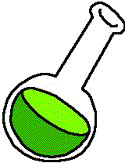 |
|
 |
|
Quantities of acid and base present in a sample, as well their pKa values can be determined from the analysis of titration curves. Three types of acid-base titrations are often used:
1) Titration of Strong Acid with Weak Base
2) Titration of Weak Acid and Strong Base
3) Tritration of Weak Base with Strong Acid
As bioanalytical chemists what we really care about is the activity of a substance. Activity is defined by Daniel C. Harris in Quantitative Chemical Analysis as "the value that replaces concentration in a thermodynamically correct equilibrium expression.
Where gc is the activity coefficient and [X] is the concentration.
The activity coefficient is the number by which the concentration must be multiplied to get the activity.
Using the above equation allows for the effect of ionic strength on the equilibrium because the activity depends on ionic strength.
Now you might be asking yourself, "How in the world am I ever going to find out what the activity coefficient, g, is?" Well, that's when we ask our good friends Debye and Huckel.
Where g is the activity coefficient of an ion of charge +/-z and a is the size of the ion in pm in aqueous solution of ionic strength m.
Knowledge of a substance's activity is key to bioanalytical chemists and should always be used in place of a substance's concentration. So, if you ever catch yourself finding the pH of a solution using the [H+], take a step back and remember your g !
Another very important part of acid-base chemistry for bioanalytical chemist is the notion of alpha fractions. For each species present in a titration, a fraction of it exists as either acid or base. This fraction will be helpful in several different titrations and equilibria.
In monoprotic systems-
Since much of bioanalytical chemistry involves diprotic acids as well as monprotic acids, a alpha fractions are integral to diprotic systems. The same pattern is used as was used above.
Much of acid-base chemistry revolves around the use titration curves. However, in order to really understand and use the information, one must know how much of the species exists in each form. This is when our trusty alpha fractions come to the rescue. In order to carry out effective amino acid chemistry, alpha fractions are a necessity.
Adams, K. R.; Meyers, M. B. Activation energies for an enzyme-catalyzed and acid catalyzed hydrolysis: An introductory interdisciplinary experiment for chemists and biochemists. J. Chem. Educ. 1985 62 86.
Bonham, Russell A. Determination of the Equilibrium Constants
of a Weak Acid: An Experiment for Analytical or Physical Chemistry
J. Chem. Educ. 1998 75 631. (May 1998)
Chirpich, Thomas P. "Rubberized" bone: A demonstration
of solubility principles, acid base reactions, and biochemistry.
J. Chem. Educ. 1986 63 519.
Hammett, Louis P. The theory of acids and bases in analytical
chemistry. J. Chem. Educ. 1940 17 131.
Patterson, George S. A Simplified Method for Finding the pKa
of an Acid-Base Indicator by Spectrophotometry J. Chem. Educ.
1999 76 395. (March 1999)
Rao, T. S.; Dabke, R. B.; Biradar, B. S. Equilibrium Constant
of the Oxidation of Ascorbic Acid (Vitamin C): An Experiment in
Biochemistry Laboratory. J. Chem. Educ. 1994 71
438.
Riyazuddin, P.; Devika, D. Potentiometric Acid-Base Titrations
with Activated Graphite Electrodes J. Chem. Educ. 1997
74 1198. (October 1997)
Silva, Cesar R.; Simoni, Jose A.; Collins, Carol H.; Volpe, Pedro
L. O. Ascorbic Acid as a Standard for Iodometric Titrations. An
Analytical Experiment for General Chemistry J. Chem. Educ.
1999 76 1421. (October 1999)
Summerfield, John H. An Acid-Base Chemistry Example: Conversion of Nicotine J. Chem. Educ. 1999 76 1397. (October 1999)
Thompson, Robert Q. Identification of weak acids and bases by titration with primary standards: A modern version of an old analytical chemistry experiment. J. Chem. Educ. 1988 65 179.
Effects of lysine on ammonia formation, hydrogen ion, and potassium
ion balance. Review and an hypothesis
Author: Zweig, Jack I. Source: Clin. Chem. 19, no. 9 (1973): 943-9
Review lecture. Central chemosensitivity and the reaction theory
Author: Loeschcke, H. H. Source: J. Physiol. (London) 332 (1982):
1-24, 1 plate
Strategies for the recovery of chemicals from fermentation:
a review of the use of polymeric adsorbents
Author: Garcia, Antonio A. Source: Biotechnol. Prog. 7, no. 1
(1991): 33-42
For interesting medical applications and interactive fun:
http://www.tmc.tulane.edu/departments/anesthesiology/acid/acid.html
For an acid-base tutorial and links to other acid/base web material:
http://astro.ocis.temple.edu/~piram/projects.html
For a quick review of acids, bases and pH:
http://web.jjay.cuny.edu/~acarpi/NSC/7-ph.htm
For a summary of acid-base chemistry:
http://hamers.chem.wisc.edu/chapman/AcidBase/summary.html
Return to Bioanalytical Home Page